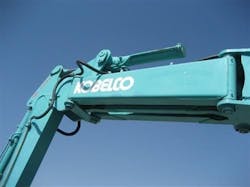One of our members described the layout of a rear-mounted knuckle crane on a truck, which was giving trouble, as follows:
"The pump is a bent axis Muncie pump 20 GPM, 4300 PSI. The pressure line is 3/4" hose and steel tube. The pump intake line is a 2" suction hose from the tank located on the crane base to a 1-3/4" steel pipe under the truck bed and back up to a 2" hose between the steel pipe and pump. Total length of each line (pressure and intake) is 33 feet. The intake line also features one, 45-degree fitting and three long-radius, 90-degree bends."
One of the great advantages of a hydraulic system is that components can be mounted with little regard to alignment, and within reason, proximity to other components with which they must connect. But as I think the above set-up shows, this advantage can be taken too far.
In case you missed it, the hydraulic tank is incorporated in the knuckle crane, which is mounted on the rear of the truck. The pump of course has to be driven from the power take off, usually from the gear box, near the front of the truck. With the result, that on this truck, the length of the intake (and pressure) line is 33 feet.
It is very convenient to incorporate the hydraulic tank in the knuckle crane: once the crane is mounted, and the pump is mounted, there are just two hydraulic lines to run between the pump and crane. A cinch, on paper at least. Except running 1-3/4" steel pipe most of the length of the chassis for the pump intake is certainly no cake walk. But of course the real kicker is having an intake line 33 feet long--not to mention the 45-degree elbow and three bends.
It'll work, sure. But this long and torturous intake line will have a negative effect on pump service-life over time. And this is not a cheap pump we're talking about (not that there is really any such thing as a cheap pump!). It's a high-pressure, bent-axis piston pump.
The only saving grace may be that the nature of this application is intermittent use. So the pump could last for many years, while still failing after a relatively short life when measured in actual operating hours.
But if this was my truck, I'd be crunching the numbers on mounting a separate hydraulic tank close to the pump (assuming that's physically possible). And the numbers might not stack up. Because once something is done, there is waste associated with having it undone. So I could be stuck with a system that, for the sake of convenience, is designed to fail.
In other words, failure to consider component service life and longevity when a hydraulic system is built can be very costly in the long run. And to discover six other costly mistakes you want to be sure to avoid with your hydraulic equipment, get "Six Costly Mistakes Most Hydraulics Users Make... And How You Can Avoid Them!" available for FREE download here.
About the Author
Brendan Casey
Founder and author
Brendan Casey is the founder of HydraulicSupermarket.com and an author of several hydraulic maintenance and troubleshooting books. A hydraulics specialist with an MBA, he has more than 20 years experience in the design, maintenance and repair of mobile and industrial hydraulic equipment. Visit his website, www.hydraulicsupermarket.com, for more information.

Leaders relevant to this article:
